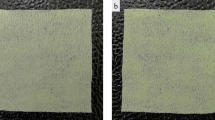Abstract
Background
Although many mechanical devices are being developed for functional end-to-end anastomosis (FETEA), the best choice remains to be determined. The mechanical strength of each device is an important factor associated with anastomotic leakage. In turn, anastomotic patency is related to postoperative stenosis. This study examined the bursting pressure and circumference of several FETEAs.
Methods
Young domestic pigs were used in this study. In experiment 1, a 10-cm segment of intestine was transected using an EndoGIA 60 blue, EndoGIA 60 green, or GIA 60 blue stapler, and the bursting pressure of each instrument’s mechanical staple line was examined. In experiment 2, after FETEA had been created with EndoGIA 60 blue, the bursting sites were examined, and the bursting pressures of buttressed and nonbuttressed FETEA were measured and compared. In experiment 3, the circumference of FETEA was compared between the closed technique and reinforcement.
Results
The bursting pressure of EndoGIA 60 blue was significantly higher than that of the other devices. When an anastomotic crotch was buttressed, the bursting pressure (44 ± 13 mmHg) was significantly increased over that of the nonbuttressed FETEA (27.5 ± 5.8 mmHg; p < 0.05). The circumference of FETEA using the wide technique (92.7 ± 2.3 mm) was larger than that using the offset technique (55.7 ± 5.8 mm).
Conclusions
The bursting pressure of the mechanical staple line using the EndoGIA 60 stapler was the strongest. Functional end-to-end anastomosis was stronger when created with buttress of an anastomotic crotch, and larger circumferences were created with the wide technique.


Similar content being viewed by others
References
Arnold W, Shikora SA (2005) A comparison of burst pressure between buttressed versus nonbuttressed staple-lines in an animal model. Obes Surg 15: 164–171
Bluett MK, Healy DA, Kalemeris GC, O’Leary JP (1986) Comparison of automatic staplers in small bowel anastomoses. Southern Med J 79: 712–716
Chassin JL, Rifkind KM, Sussman B, Kassel B, Fingaret A, Drager S, Chassin PS (1978) The stapled gastrointestinal tract anastomosis. Ann Surg 188: 689–696
Hardcare JM, Mendoza-Sagaon M, Murata K, Talamini MA (2000) Use of a cauterizing laparoscopic linear stapler in intestinal anastomosis. Surg Laparosc Endosc Percutan Tech 10: 128–132
Ostericher R, Lally KP, Barrett DM, Richey ML (1991) Anastomotic obstruction after stapled enteroanastomosis. Surgery 109: 799–801
Pappas TN, Chekan EG, Eubanks S (1999) Atlas of laparoscopic surgery. 2nd ed. Current Medicine, Inc., Philadelphia
Ravitch MM, Steichen FM (1979) A stapling instrument for end to end inverting anastomosis in the gastrointestinal tract. Ann Surg 189: 791–797
Ritchey ML, Lally KP, Ostericher R (1993) Comparison of different techniques of stapled bowel anastomoses in a canine model. Arch Surg 128:1365–1367
Roumen RMH, Rahusen FTG, Wijnen MHWA, Croiset van Uchelen GAAM (2000) “Dog ear” formation after double-stapled low anterior resection as a risk factor for anastomotic disruption. Dis Colon Rectum 43: 522–525
Rullier E, Laurent C, Garrelon JL, Michel P (1998) Risk factors for anastomotic leakage after resection of rectal cancer. Br J Surg 85: 355–358
Sadahiro S, Kameya T, Iwase H, Ishhikawa K, Suzuki T, Tokunaga N, Tajima T, Makuuchi H (1999) Which technique, circular stapled anastomosis or double stapling anastomosis, provides the optimal size and shape of rectal anastomotic opening? J Surg Res 86: 162–166
Schauer PR, Ikramuddin S, Gourash WF, Ramanathan R, Luketich J (2000) Outcomes after laparoscopic Roux-en-Y gastric bypass for morbid obesity. Ann Surg 232: 515–529
Schwab R, Weşendorf S, Gutcke A, Becker HP (2002) Early bursting strength of human colon anastomoses: an in vitro study comparing current anastomotic techniques. Langenbeck Arch Surg 386: 507–511
Steichen FM (1968) The use of staplers in anatomical side-to-side and functional end-to-end enteroanastomoses. Surgery 64: 948–953
Steichen FM, Ravitch MM (1973) Mechanical sutures in surgery. Br J Surg 60: 191–197
Wittgrove AC, Clark GW (2000) Laparoscopic gastric bypass, Roux-en-Y-500 patients: technique and results with 3-60 month follow-up. Obes Surg 10: 233–239
Acknowledgment
We thank Tyco Healthcare Japan for the technical support.
Author information
Authors and Affiliations
Corresponding author
Rights and permissions
About this article
Cite this article
Goto, T., Kawasaki, K., Fujino, Y. et al. Evaluation of the mechanical strength and patency of functional end-to-end anastomoses. Surg Endosc 21, 1508–1511 (2007). https://doi.org/10.1007/s00464-006-9131-6
Received:
Revised:
Accepted:
Published:
Issue Date:
DOI: https://doi.org/10.1007/s00464-006-9131-6




